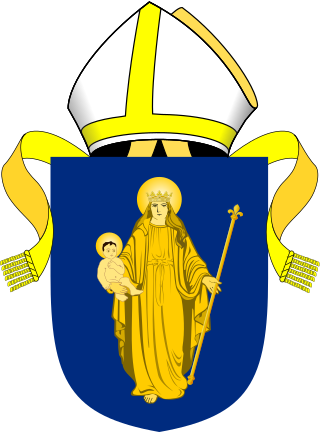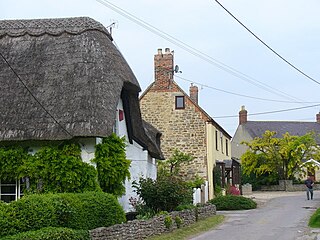
Avebury is a village and civil parish in Wiltshire, England. The village is about 5.5 miles (9 km) west of Marlborough and 8 miles (13 km) northeast of Devizes. Much of the village is encircled by the prehistoric monument complex also known as Avebury. The parish also includes the small villages of Avebury Trusloe and Beckhampton, and the hamlet of West Kennett.

Berwick Bassett is a small village and civil parish in Wiltshire, England, about 6 miles (10 km) northwest of Marlborough and 8 miles (13 km) southwest of Swindon. The village is on the west bank of a headstream of the River Kennet and close to the A4361 road, formerly the A361, which links Devizes and Avebury with Wroughton and Swindon.
Broad Hinton and Winterbourne Bassett is a parish council area comprising the adjacent civil parishes of Broad Hinton and Winterbourne Bassett, in the English county of Wiltshire.

Broad Hinton is a village and civil parish in Wiltshire, England, about 5 miles (8 km) southwest of Swindon. The parish includes the hamlets of Uffcott and The Weir.

West Overton is a village and civil parish in the English county of Wiltshire, about 3.5 miles (5.6 km) west of Marlborough. The river Kennet runs immediately north of the village, separating it from the A4 road. The parish includes the village of Lockeridge, also near the river, further east (downstream).

The Diocese of Salisbury is a Church of England diocese in the south of England, within the ecclesiastical Province of Canterbury. The diocese covers the historic county of Dorset, and most of Wiltshire. The diocese is led by Stephen Lake, Bishop of Salisbury, and by the diocesan synod. The bishop's seat is at Salisbury Cathedral.

Winterbourne Monkton is a small village and civil parish in Wiltshire, England, about 1 mile (1.6 km) north of Avebury Stone Circle and 6 miles (10 km) northwest of Marlborough.

Winterbourne Gunner is a village and former civil parish, now in the parish of Winterbourne, in Wiltshire, England, about 4 miles (6 km) northeast of Salisbury. The village is near the River Bourne and the A338 road, and is close to Winterbourne Dauntsey. In 1931 the parish had a population of 292. On 1 April 1934, the parish was abolished and merged with Winterbourne Earls and Winterbourne Dauntsey to form Winterbourne parish.

Broad Town is a village and civil parish in Wiltshire, England, about 3 miles (5 km) southeast of Royal Wootton Bassett and 6 miles (10 km) southwest of Swindon. The parish includes the hamlet of Thornhill and the farming hamlet of Cotmarsh.

Limpley Stoke is a village and civil parish in Wiltshire, England. It lies in the Avon valley between Bath and Freshford, and is both above and below the A36 road.

Clyffe Pypard is a village and civil parish about 3+1⁄2 miles (5.6 km) south of Royal Wootton Bassett in North Wiltshire, England.

Milton Lilbourne is a village and civil parish in the county of Wiltshire, England, in the Vale of Pewsey between Pewsey and Burbage. It is largely a mixed residential area centred on the Manor. The nearest town is Marlborough, 5.5 miles (8.9 km) to the north.

Woodborough is a small village and civil parish in the Vale of Pewsey, Wiltshire, England, about 3.5 miles (5.6 km) west of Pewsey.

Winterbourne Earls is a village in Wiltshire, England. The village is in the Bourne valley on the A338 road, about 3.4 miles (5 km) northeast of Salisbury.

Great Hinton is a small village and civil parish about 3 miles (4.8 km) south of Melksham and 3.5 miles (5.6 km) north-east of Trowbridge in Wiltshire, England. The parish includes the hamlets of Bleet and Cold Harbour.

Winterbourne Stoke is a village and civil parish in Wiltshire, England, about 5 miles (8 km) west of Amesbury and 3 miles (4.8 km) west of the prehistoric monument of Stonehenge.

The Church of St Mary Magdalene is the Anglican church in the village of Winterbourne Monkton, north of Avebury in Wiltshire, England. It is a 19th-century rebuilding of a structure dating from the 14th century.

Hinton Parva, also known as Little Hinton, is a village in the Borough of Swindon in Wiltshire, England. It lies about 2 miles (3.2 km) from the eastern edge of the Swindon built-up area, and is separated from the town by farmland and the village of Wanborough. The village has a Grade I listed church which has Norman origins. Hinton Parva was a separate civil parish until 1934, and is now in the parish of Bishopstone.

St Nicholas's Church in Berwick Bassett, Wiltshire, England dates from the early 13th century. It is recorded in the National Heritage List for England as a Grade II* listed building, and is now a redundant church in the care of the Churches Conservation Trust. It was declared redundant in 1972, and was vested in the Trust the next year. Services continue to be held at the church a few times a year.

Winterbourne is a civil parish in south east Wiltshire, England, about 3.5 miles (6 km) northeast of Salisbury. The parish encompasses the contiguous villages of Winterbourne Dauntsey, Winterbourne Earls and Winterbourne Gunner, together with the hamlet of Hurdcott south of Winterbourne Earls.





















